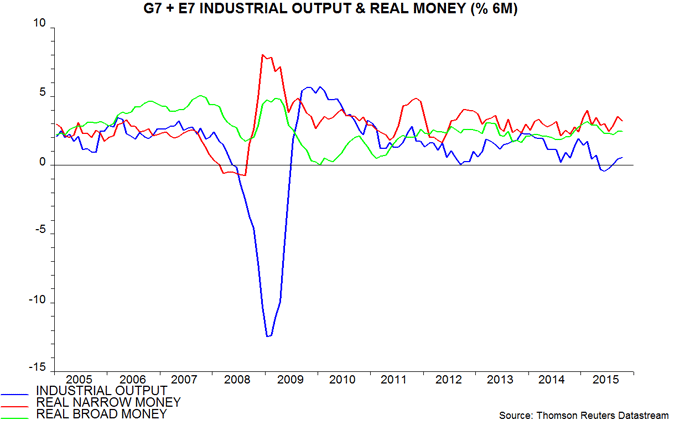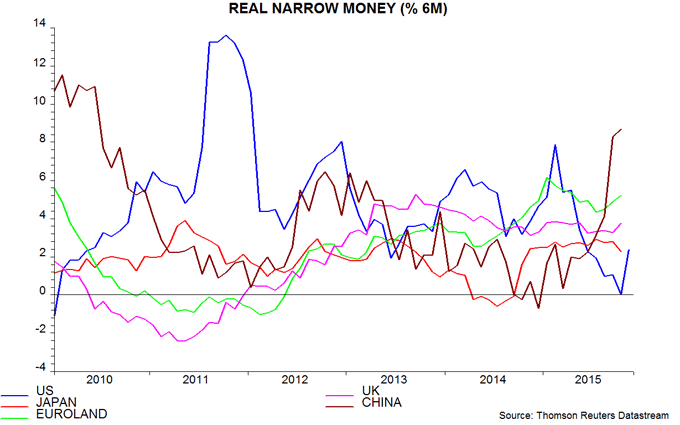Global economic update: when will Chinese news improve?
Global real narrow money* has been growing solidly in recent months, with strength in the Eurozone and China offsetting weakness in the US. Reflecting these trends, previous posts have suggested that:
1) Global economic growth would recover in late 2015 / early 2016.
2) The recovery would be driven by Europe / Asia, with US growth moderate at best.
3) This rotation would be welcomed by equity market investors, with stronger non-US growth supporting earnings expectations and a sluggish US tempering worries about the pace of Fed tightening.
Is this scenario panning out?
On 1), available data suggest that the six-month rate of change of global industrial output recovered further in October – see first chart. As noted on Monday, Korean companies are usually sensitive to changes in the global environment and have become significantly more optimistic, according to the latest Federation of Korean Industries survey. The Markit / J P Morgan global manufacturing purchasing managers’ index (PMI), however, was little changed in November.
On 2), the November manufacturing PMIs for Japan and the Eurozone were upbeat, while US results surprised negatively. The Chinese official and Markit / Caixin surveys, however, remained weak.
On 3), investors are sceptical that non-US growth can take up the baton if the US slows. Weaker US news, therefore, is producing a mixed market reaction, with earnings concerns offsetting the implied reduction in Fed tightening risk.
To summarise, the evidence to date partially supports the suggested scenario but more convincing signs of non-US economic improvement are needed – particularly better news from China.
When might this occur? Analysis of G7 data extending back to the 1960s indicates that real narrow money leads industrial output by nine months on average. This rule-of-thumb signalled, to within one month, the end of the 2008-09 recession: the six-month change in G7 real narrow money surged from August 2008, while the six-month industrial output change recovered strongly from April 2009 (i.e. eight months later).
Six-month growth of Chinese real narrow money rose significantly after March 2015, so the nine-month rule-of-thumb suggests a pick-up in industrial output momentum from end-2015. Allowing for reporting lags, therefore, Chinese economic news may show a convincing improvement in February / March 2016.
Risks to the suggested scenario include 1) the Chinese narrow money surge is a false positive signal and 2) the US economy is entering a period of weakness, rather than slowing modestly. The former possibility was considered in a previous post and judged to be unlikely. US weakness is a greater risk: in addition to slowing real narrow money expansion, the stocks cycle is turning down while corporate finances have deteriorated, questioning prospects for business investment and hiring. The monetary evidence, however, is currently flashing amber rather than red, with signs of improvement in weekly data for November – second chart**.
*Global = G7 plus emerging E7. Narrow money = currency in circulation plus demand / overnight deposits. Real = deflated by consumer prices.
**The final US data point is an estimate for November; other series are up to October.



Reader Comments